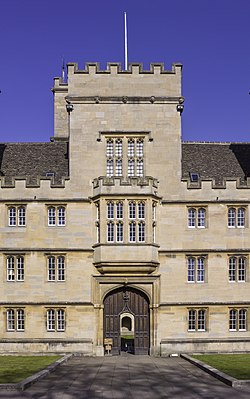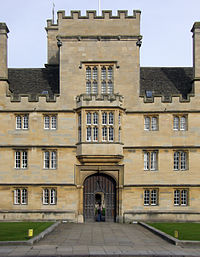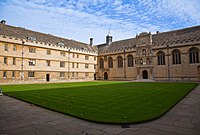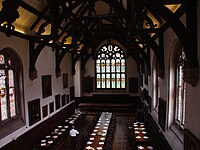Wadham College, Oxford
| Wadham College Latin: Collegium Wadhamensi
| |||||||||||

| |||||||||||
|---|---|---|---|---|---|---|---|---|---|---|---|
| Warden: | Robert Hannigan | ||||||||||
| Website: | wadham.ox.ac.uk | ||||||||||
| |||||||||||
| Location | |||||||||||
| Grid reference: | SP51550662 | ||||||||||
| Location: | 51°45’21"N, 1°15’17"W | ||||||||||
Wadham College is one of the constituent colleges of the University of Oxford, located in the centre of Oxford, at the intersection of Broad Street and Parks Road. Wadham College was founded in 1610 by Dorothy Wadham, according to the will of her late husband Nicholas Wadham, a member of an ancient Devon and Somerset family.
The central buildings, a notable example of Jacobean architecture, were designed by the architect William Arnold and erected between 1610 and 1613. They include a large and ornate Hall. Adjacent to the central buildings are the Wadham Gardens. Wadham is one of the largest colleges of the University of Oxford, with about 480 undergraduates and 240 graduate students. The college publishes an annual magazine for alumni, the Wadham College Gazette.[1] As of 2022, it had an estimated financial endowment of £113 million,[2] and in the 2021-2022 academic year ranked 7th in the Norrington Table, a measure which ranks Oxford colleges by academic performance.[3]
Amongst Wadham's most famous alumni is Sir Christopher Wren. Wren was one of a brilliant group of experimental scientists at Oxford in the 1650s, the Oxford Philosophical Club, which included Robert Boyle and Robert Hooke. This group held regular meetings at Wadham College under the guidance of the warden, John Wilkins, and the group formed the nucleus which went on to found the Royal Society.
Contents
History
17th century
The college was founded by Dorothy Wadham (née Petre) in 1610,[4] according to the wishes set out in the will of her husband Nicholas Wadham. Over four years, she gained royal and ecclesiastical support for the new college, negotiated the purchase of a site, appointed the West Country architect William Arnold, drew up the college statutes, and appointed the first warden, fellows, scholars, and cook. Although she never visited Oxford, she kept tight control of her new college and its finances until her death in 1618.[5]
The wardenship of John Wilkins (1648–1659) is a significant period in the history of the college. Wilkins was a member of a group which had met for some years in London to discuss problems in the natural sciences. Many of the group moved to Oxford and held regular meetings in the Warden's lodgings at Wadham. Among them were Robert Boyle, Robert Hooke, John Locke, William Petty, John Wallis, and Thomas Willis. Wadham provided the largest contingent, some twelve of the fifty names mentioned. These included Christopher Brookes (mathematician and instrument-maker), John Mayow (a distinguished chemist and physician), Lawrence Rooke (later astronomy professor at Gresham College, London), Thomas Sprat (later the official historian of the Royal Society), Seth Ward (mathematician and Savilian Professor of Astronomy), and Christopher Wren|Sir Christopher Wren (mathematician and Savilian Professor of Astronomy).[6]
Sir Christopher Wren was an undergraduate at Wadham before he became a fellow of All Souls and then succeeded Rooke as astronomy professor at Gresham College, London. He eventually returned to occupy rooms at Wadham while he was the Savilian Professor of Astronomy from 1661. Wren had notable achievements in pure and applied mathematics, astronomy, physics and biology to his credit before he turned to architecture, in his thirties.[6] In mathematical ability alone, Wren was ranked by competent authorities second only to Newton among the men of his time.[7]
The Warden's lodgings were stuffed with ingenious instruments, and powerful telescopes were mounted on the college tower. The Oxford group kept up close relations with their colleagues in London, and in 1660, at Gresham, the decision was taken to create the body which, in 1662, was to be formally incorporated as the Royal Society. Wilkins was the first president of the provisional body, and became the first secretary of the Royal Society itself. These were the beginnings of organised scientific research in Britain.[6]
Buildings
Front quad
Wadham is sometimes put forward as the last major public building to be created according to the mediæval tradition of the Master Mason. Wadham's front quadrangle (quad), which served as almost the entire college until the mid-20th century, is also an early example of the "Jacobean Gothic" style that was adopted for many of the university's buildings.
The main building was erected in a single building operation in 1610–1613. The architect, William Arnold, was also responsible for Montacute House and Dunster Castle in Somerset, and was involved in the building of Cranborne Manor in Dorset for Robert Cecil, 1st Earl of Salisbury, James I's Lord Treasurer. The style of the building is a fairly traditional Oxford Gothic architecture|Gothic, modified by classical decorative detail, most notably the 'frontispiece' framing statues of James I and the Founders immediately facing visitors as they enter the college. Classical, too, is the over-powering emphasis on symmetry. The central quadrangle was originally gravelled throughout; the present lawn was laid down in 1809. The college was refaced in the 1960s, and much of the front quad has undergone further restoration work.
Hall
In 1898, the hall was the third largest amongst Oxford colleges after Christ Church and New College. It is notable for its great hammer-beam roof and for the Jacobean woodwork of the entrance screen. The portraits include those of the founders and of distinguished members of the college. The large portrait in the gallery is of John Lovelace, who held Oxford for William of Orange during the Revolution of 1688; the inscription records his role in freeing England 'from popery and slavery'.[8]
Chapel
Although a ceremonial door opens directly into Front Quad, the chapel is usually reached through the door in staircase 3. The screen, similar to that in the hall, was carved by John Bolton. Originally Jacobean woodwork ran right round the chapel. The present stone reredos was inserted in the east end in 1834. The elegant young man reclining on his monument is Sir John Portman, baronet, who died in 1624 as a nineteen-year-old undergraduate. Another monument is in the form of a pile of books; it commemorates Thomas Harris, one of the fellows of the college appointed at the foundation. The Chapel organ dates from 1862 and 1886. It is one of the few instruments by Henry Willis, the doyen of Victorian organ builders, to survive without substantial modification of its tonal design.
Outside links
References
- ↑ Wadham College Gazette, Wadham College, https://www.wadham.ox.ac.uk/alumni/alumni-publications, retrieved 7 August 2022
- ↑ "Wadham College Annual Report and Financial Statements". http://d307gmaoxpdmsg.cloudfront.net/collegeaccounts2122/Wadham.pdf.
- ↑ "Undergraduate Degree Classifications". https://www.ox.ac.uk/about/facts-and-figures/undergraduate-degree-classifications.
- ↑ "History of Wadham". www.wadham.ox.ac.uk. http://www.wadham.ox.ac.uk/about-wadham/history-of-wadham/history-of-wadham-2.html.
- ↑ Davies, C.S.L. (Sep 2003). "A Woman in the Public Sphere; Dorothy Wadham and the Foundation of Wadham College, Oxford". The English Historical Review 118 (478): 883–911. doi:10.1093/ehr/118.478.883.
- ↑ 6.0 6.1 6.2 C. Davis and J. Garnett (2008). Tutorial Teaching at Wadham: A History. Oxford: The Development Office of Wadham College.
- ↑ Wells, Joseph (1898). Wadham College. London: F. E. Robinson. https://archive.org/details/wadhamcollege00wellrich.
- ↑ "John, Baron Lovelace (c.1638–1693) | Art UK" (in en). https://artuk.org/discover/artworks/john-baron-lovelace-c-16381693-223924.
- Nikolaus Pevsner: The Buildings of England: Oxfordshire, 1974 Penguin Books ISBN 978-0-300-09639-2
| Colleges of the University of Oxford | |
|---|---|
| Colleges:
All Souls • Balliol • Brasenose • Christ Church • Corpus Christi • Exeter • Green Templeton • Harris Manchester • Hertford • Jesus • Keble • Kellogg • Lady Margaret Hall • Linacre • Lincoln • Magdalen • Mansfield • Merton • New College • Nuffield • Oriel • Pembroke • The Queen's • Reuben • St Anne's • St Antony's • St Catherine's • St Cross • St Edmund Hall • St Hilda's • St Hugh's • St John's • St Peter's • Somerville • Trinity • University • Wadham • Wolfson • Worcester |
|
| Permanent private halls:
Blackfriars • Campion Hall • Regent's Park College • St Benet's Hall • St Stephen's House • Wycliffe Hall | |






